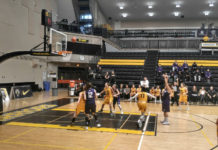The Canadian Clay and Glass Gallery in uptown Waterloo has displayed two new exhibits, each with a touch of nature. </p>
Flower Vases with Flowers in a Vase by Paul Mathieu relies heavily on the fauna of famous painters, while Awestruck Calendar of Ecology by Julie Oakes explores the ideal natural world including animals, plants, and geographical aspects such as rivers. The exhibits were curated by Christian Bernard Singer and will be open for viewing until Jan. 3, 2016. Andrew Eucsis, the curatorial assistant, commented, “The turnout has been wonderful — everybody that has come through the door has responded most favourably.”
Flower Vases with Flowers in a Vase forces the viewer to expand their vision and take in not only the whole, but the minutest details of each stroke that the flower petals consists of. Mathieu uses multiple copies of Henriette, the sculpture head created by Matisse in 1927. The distinction in the copy and the original is that Mathieu has inverted the head so that it rests on its crown, and its neck is open to be filled with flowers. This is demonstrated in the middle vase of the exhibit that is filled with sunflowers. The ceramic vases themselves are decorated with reproductions and imitations of other famous still-life paintings of flowers. Some of these reproductions include Vincent van Gogh’s Sunflowers and Roses Blanches, as well as other painters such as Matisse, Redon, and Picasso.
The ceramic vases are not the only aspects of this exhibit. Collages cover the walls, displaying the many facets and angles of the paintings, and how they are portrayed onto the vases. According to Eucsis, the collages are held up by magnets to give the appearance of floating. Overall, this exhibit pushes past the boundary of common still-life paintings and pulls ceramics into the centre of art instead of its marginal foothold in the art world.
Awestruck Calendar of Ecology also expands the mind of the viewer, but in a far different way. Oakes has created sculptures and installations that momentarily transport the viewer to a world of sublime nature. Combining natural ideas and concepts with man-made materials such as shattered blue glass bottles, Oakes’ narrative leaves the viewer conflicted at the horror of his own impact on nature and the beauty that man is able to create in the wake of its destruction.
According to the Clay and Glass Gallery’s website, Oakes defined her exhibit as “a wounding devastation that is both natural and man-made.”
This exhibit uses not only fearfully beautiful and delicate installations of crushed blue glass bottles that suggest a river and glass birds in different stages of flights, but also bronze heads, tapestries, and paintings. An interesting installation in this exhibit is a mobile bird whose posture and form change endlessly as it spirals. With a total of 120 glass birds, the installation required two days of work, many wires, and a grid on the roof to support the delicate creatures.
Other pieces, such as the bronze head of a Winter Mouse, add to the magic Oakes is presenting in her idealized natural world. The cast full round sculpture has added details of flowers on the winter animal, creating the illusion that nothing dies in the winter and that things continue to grow. This speaks to the concerns for the sustainability of the planet, a narrative of her exhibit.
This narrative expands into the paintings as well. The animals in the paintings have large eyes, with vibrant colours. Each set of eyes is both knowing and disappointed and each set is remarkably aware of its surrounding and state — a feature that we as humans have failed to grasp perhaps.






























